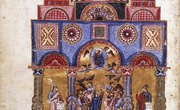During the Age of Enlightenment, the Dark Ages were overcome by the fast spread of a large number of new ideas, writings, philosophies, scientific discoveries and art. The spread of these ideas from the wealthy to the middle class was in large part due to the ability of the thinkers involved to produce printed materials.
About the Age of Enlightenment
During the Dark Ages, the French church and government believed that God wanted the world to remain exactly as it was. To stop new ideas, books were burned and writers were imprisoned. During the 1700s, an influx of Enlightenment ideas came to Paris and spread around Europe. Great scientists such as Issac Newton, artists of the Baroque period and musicians such as Johann Sebastian Bach flourished during this period. Their impact can still be felt, 300 years later.
Paris Salons
The Enlightenment ideas started in the salons of Paris. The wealthy women of Paris held gatherings in their homes, called salons, where their peers could hear inspiring music, view art and listen to ideas and writings from great thinkers. These salonnieres supported artists, musicians, philosophers and writers and were responsible for making France the intellectual center of Europe. The most popular of all salonnieres was Marie-Therese Geoffrin, a member of the wealthy French middle class.
Diderot’s Encyclopedia
The ideas of Enlightenment reached a much wider audience when Geoffrin helped to finance the writing of Denis Diderot's Encyclopedia. The encyclopedia gathered all the most current ideas about music, art, writing, philosophy, government and science. It was widely published and made available to the French middle class. The first volumes of the Encyclopedia were published in 1751. Diderot persisted in requesting permission to print his work, even when the French government and church were angered by it. He was successful, and new volumes were published until 1771.
Newspapers and Pamphlets
The thinkers responsible for the Enlightenment ideas considered themselves part of an intellectual community. They produced printed materials in such quantity that the new ideas spread quickly from the wealthy to the middle class, who had enough money to support the intellectuals who produced them by buying books and reading magazines. These people often didn't have the clout to make a political difference, but they could put their money to good use. This fast spread of ideas via printed material helped to solidify the Age of Enlightenment and the ideas that formed it.
Related Articles
References
Writer Bio
Shaunta Alburger has been a professional writer for 15 years. She's worked on staff at both major Las Vegas newspapers, as well as a rural Nevada weekly. Her first novel was published in 2014.











